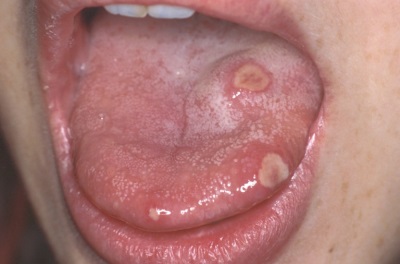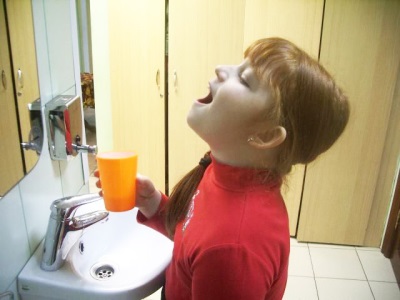Stomatitis in the language of children
Stomatitis in children is a common problem that causes significant discomfort due to the great pain. Often, when stomatitis affects the mucosa of the tongue. Why is this happening and how to treat such inflammation?
Symptoms
Inflammatory processes in the language appear:
- The presence of vesicles, ulcers, pustules, plaque or other elements of inflammation on the surface of the tongue, as well as their pain.
- Puffiness mucous.
- Increased body temperature. In some cases, the child’s condition may not change, and sometimes with stomatitis, the temperature may rise to 40 degrees.
- Bleeding gums.
- Violation of salivation - as a lack of saliva in the mouth, and excessive salivation.
- Unpleasant smell from the mouth.
- Anxiety and crying, if the disease appeared in a very young child.

The reasons
Normally, the mucous membrane of the tongue is protected from damage by saliva, so the appearance of stomatitis on the tongue often requires the coincidence of several factors, for example, trauma to the mucous membrane and the ingress of bacteria into the oral cavity.
To stomatitis in the language can lead such reasons:
- Viruses and bacteria. It happens that stomatitis is provoked by microorganisms that constantly dwell in the mouth of a child, but do not cause infection, since there are components with antiseptic effects in the saliva. With violations of saliva production and an increase in the number of microorganisms in the mouth, wounds can form in the tongue. Also, germs and viruses can be activated by weakening the immune system or taking antibacterial agents. In addition, stomatitis in the tongue can be caused by pathogenic viruses (for example, the herpes virus) and bacteria (very often by staphylococci).
- Fungi. They often affect the mucous membrane of the tongue in children of the first year of life, when the crumb is infected with Candida from the mother, through a pacifier or toys. Also, the fungal flora can be activated with long-term treatment (especially with anti-immunity treatments) and the use of sugar-containing mixtures.
- Non-compliance with oral hygiene. If a child brushes his teeth incorrectly or very rarely, does not cleanse the mouth of food residues, or licks dirty hands, this often provokes inflammation.
- Disruption of the digestive tract. The state of the tongue may signal problems in the digestive system, so if you have frequent stomatitis, you should consult a gastroenterologist.
- Worms The defeat of worms can cause regularly repeated rashes on the surface of the tongue.
- Injury. The tongue can get hurt by teeth or some hard objects. The child may develop inflammation on the tongue after eating flakes, crackers, lollipops. Bite defects can cause permanent occurrence of stomatitis elements at the tip of the tongue.
- Allergy. Allergic reactions to food, toothpastes or medications can lead to inflammation of the mucous membrane in the tongue.
- Ingestion of toxic substances in the mouth. It may be paint, varnish, building materials or other harmful compounds that a child may accidentally lick.

Baby sensations
Since the inflammation of stomatitis is very painful, the child will complain of pain and refuse food.Sometimes the pain is so pronounced that the baby can not talk.
Treatment
Stomatitis in the tongue is most often treated at home, but if the child’s condition has not improved in 1-2 days, it should be shown to a doctor.
The disease is mainly treated symptomatically, since it is possible to influence the cause of stomatitis only in the herpetic or bacterial form. In this case, antiviral or antibacterial drugs are prescribed. In all other cases, treatment will be directed mainly at anesthesia and cleansing the tongue with antiseptics.
Antiseptic preparations
Such remedies help to remove viruses, germs and other pathogens from the tongue and oral cavity, as well as relieve some pain. Rinse can be done with furatsilinom or chlorhexidine. Also, babies recommended the use of herbal remedies, for example, infusion of calendula, oak bark or chamomile. Rinse solutions should be warm, and the procedure itself should be performed at least 6 times a day (preferably after meals).
Pain medication
Since stomatitis pain syndrome is quite pronounced, gels and sprays with substances that have anesthetic Effect. Among them are Kamistad, HexoralDentinox. Gels on the back of the tongue should be applied with a cotton swab.











